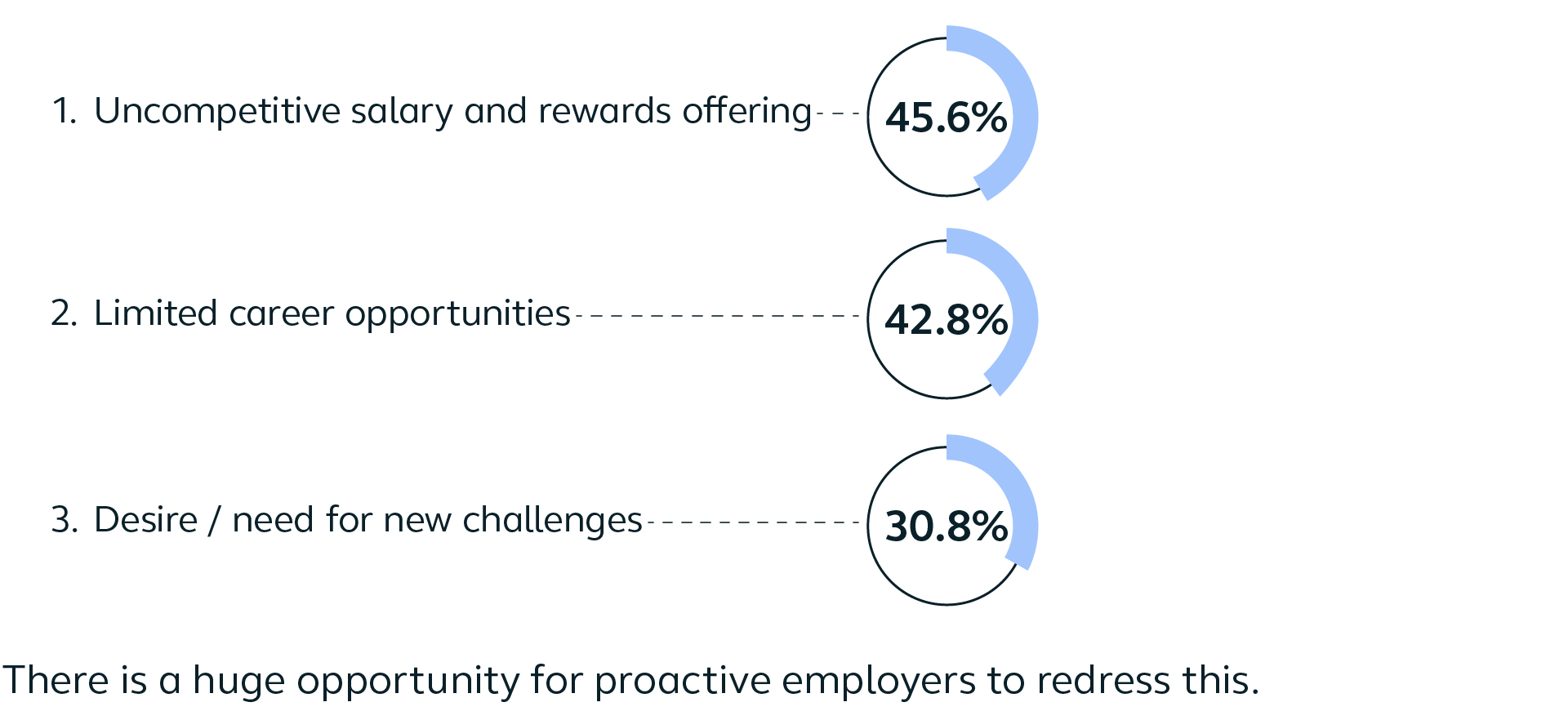The “Great Resignation” isn’t unique to any country, market, sector, or role. The gap between people leaving and joining an organisation is equal across Europe, Asia, and the US. The good news: These latest trends bring major opportunities — for employee and employers.
The widespread labour and skills shortages now faced in most sectors can be linked to years of underinvestment in employees, especially at the lower end of the wage scale. The prospect of more resignations and increasing hiring challenges are expected to be ongoing into the third year of the pandemic. Employees are shifting priorities and driving the way work, works.
New research from the Chartered Institute of Management shows resignations between April and December 2020 in the UK were higher than in the same period in 2019. And, 60% of managers in the private sector said recruitment is more challenging now than before lockdowns began.
Organisations adopting an employee-point-of-view approach at every level are set to win. There’s fierce competition for roles in firms meeting the expectations of the 21st century workforces. Regardless of role, employee aspirations and priorities have changed — in work and life. Those firms not willing or able to adapt are set to struggle.

Where did it all go wrong?
With hindsight it’s easy to see what started the shift:
- Limited career development opportunities
- Too few wellbeing check-ins
- Lapses in what made for acceptable working conditions
All of these factors played a role in employees looking to leave. Added to this were oversights in succession planning, the effects of Brexit, the pandemic, and related world-wide migration restrictions.
The world of work was hit by the perfect storm.
The real eye-opener: This storm won’t end on its own. The damage was, and continues to be, disillusioned, burned out, unchallenged, and morally tested people; employees who feel little or no assimilation or loyalty to the firms, brands, or managers they work for.
This situation is particularly noticeable in organisations with high numbers of low-paid workers such as food processing, manufacturing, casual dining, transport and logistic, and social care. The profits-first approach to running a business has been put to the test and it won’t see employers through the people-first era.
"Jobs once thought to be low-skill have been revealed to be more so than many white-collar jobs, and highly regulated in terms of ongoing training and maintaining certifications."
More Brexit changes are on the way in 2022. And the pandemic isn’t over. IR35 and similar contractor tax scenarios across the world will continue to slow the recruitment of temporary and transient workers. And the time lag for retraining and reskilling isn’t going away.
Learning how to drive a train or lorry can take more than two years. It’s expensive and the expectation is on individuals to fund their own training. Again, something employers might need to reconsider if they want to attract a younger workforce into these skilled and essential positions.
Without skilling, reskilling and upskilling the workforce, organisations are faced with the danger, quite literally in some cases, of having a largely novice workforce, with very little in-service or on-the-job training from experienced colleagues. This manifests into a getting-by approach to running a business, with little critical decision making, creativity or ability to act fast when needed. These risks apply to more than just entry-level positions.

It’s time to rethink the value of your workforce.
Why? Because your workforce is rethinking the value of you as their employer. The evidence was clearly presented to business leaders and consumers during the lockdowns. Lower-paid customer-facing jobs and services are often more critical during a crisis than higher-waged, managerial roles.
Lower-paid positions tend to be exposed to higher risk. Usual customer-facing challenges aside, vital services and supply chains continue to be disrupted by high numbers of frontline workers testing positive for the Omicron variant of COVID-19. But customer-facing roles can’t be performed from the safety of home.
Where government rulings mandated the closure of retail, leisure, travel, and service sector businesses, hundreds of thousands of workers were put on furlough or laid off. To fill the financial gap, many took work in other sectors and have chosen to stay, perhaps because the pay and conditions are more favorable or they’ve experienced being part of a firm more aligned to their principles. This includes organisations actively investing in people and the environment, rather than “profits first” at all costs.
The average age of the global workforce is falling.
The potential risks of an increasingly novice workforce due to the high number of employees leaving specific industries is a major challenge moving forward. But the latest research tells us we can’t overlook how fast the number of economically inactive adults is rising, either.
Our own Age of Agile HR research sited lack of career progression as the greatest concern for people under 40, with 49% ranking it highly. Across all age groups, the top three reasons people are leaving employment are:


Setting up employees to perform at their best.
Our global consulting teams at Alight did not pluck the idea that 2022 is the ‘Year of the Employee’ out of the air. It’s a hard reality and one shared by many of the business leaders we’re in continuous conversations with.
Much of the work we did together towards the end of 2021 was to help our clients understand how best to build, and in some cases rebuild, the talent, skills, and loyalty that might be lacking at each point on the supply chain at every level of the workforce.
The Great Resignation has transformed HR tech into a boardroom investment.
Already, investment in cloud-based HR platforms, workforce planning tools, robotic process automation, and payroll processes are on the rise — all set to improve the HR and payroll experiences and outcomes of employees from hire to retire and all in between.
In 2021, for the first time, there were more digital HR systems in use than on-premise (62% up from 34.8% in 2019). The need for remote access during lockdowns accelerated existing modernisation projects. Further research shows investment in digital and automated HR and payroll processes will top 40% in the period through 2023.
However, limitations, including the lack of real-time workforce data and analytics, has driven the business case for HR processes revitalisation to the boardroom agenda. We’re fast seeing the decision-making team extend from a single function to a cross-business team.
This is because the value of business intelligence in digital people data is now seen as key to achieving wider business objectives. Yet another piece of positive learning from the most challenging days of the pandemic.

2022 is the year HR will cement a seat in the boardroom.
No one working in the HR profession will say the past two years have been easy. However, many will say is it was the time when HR professionals proved their strategic worth. These are the HR teams able to bring people data and insights to the boardroom at times of immediate critical need.
10 key areas of focus for HR in 2022
- Data-based workforce decision making
- Automating core HR processes
- Pushing the boundaries on people, processes, and technology innovation
- Self-service HR modules
- Talent acquisition and retention — activating employee potential
- Employee development — from boardroom to shop floor
- Creating a ‘great place to work’ employer brand
- Putting diversity and inclusion at core of business strategy
- Managing a hybrid workplace
- Leading and driving sustainable changes to how and where we work
By working together to make 2022 the year of the employee, there is every likelihood this will be the year successful people will build, grow, and maintain successful businesses.






